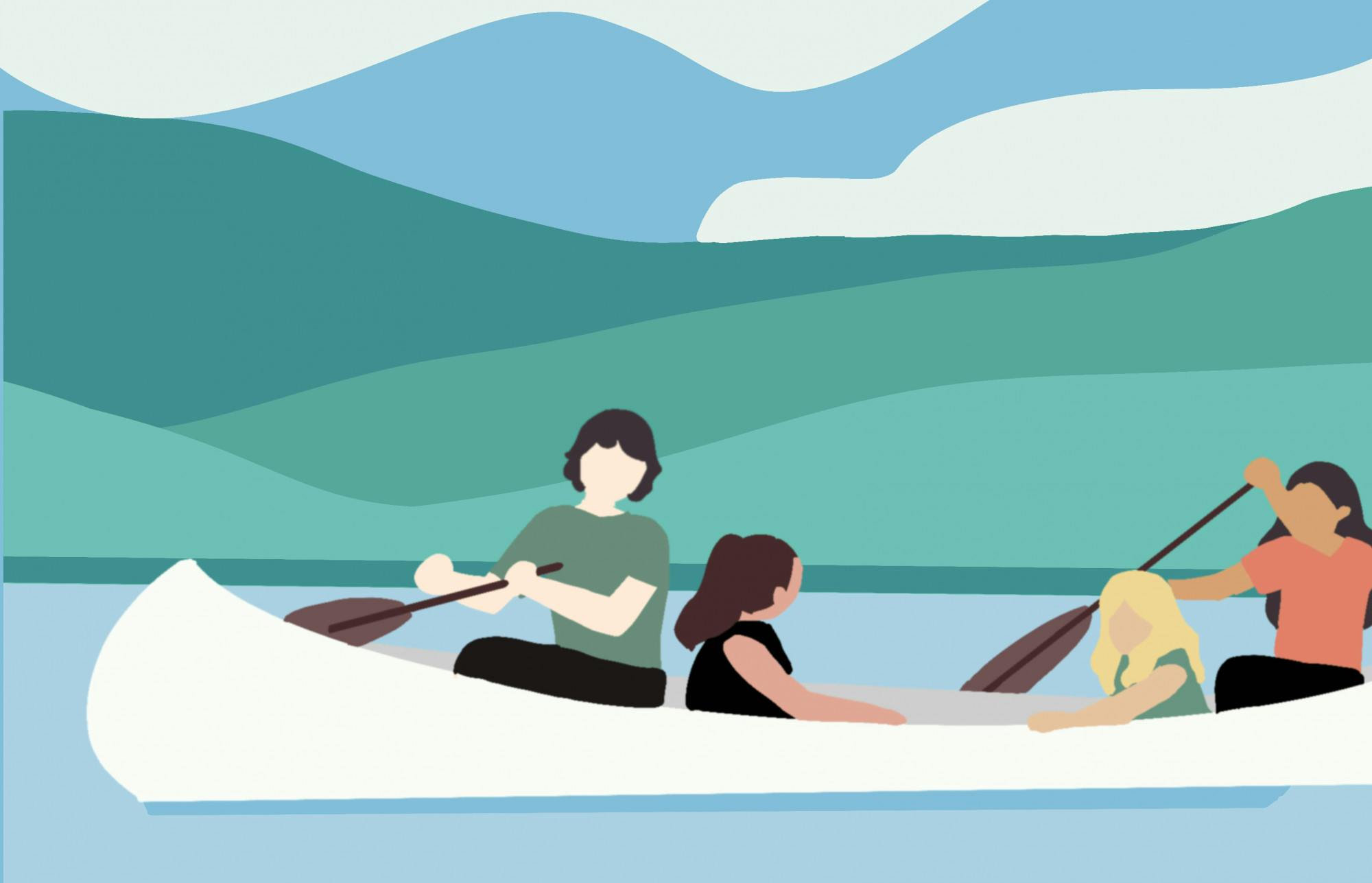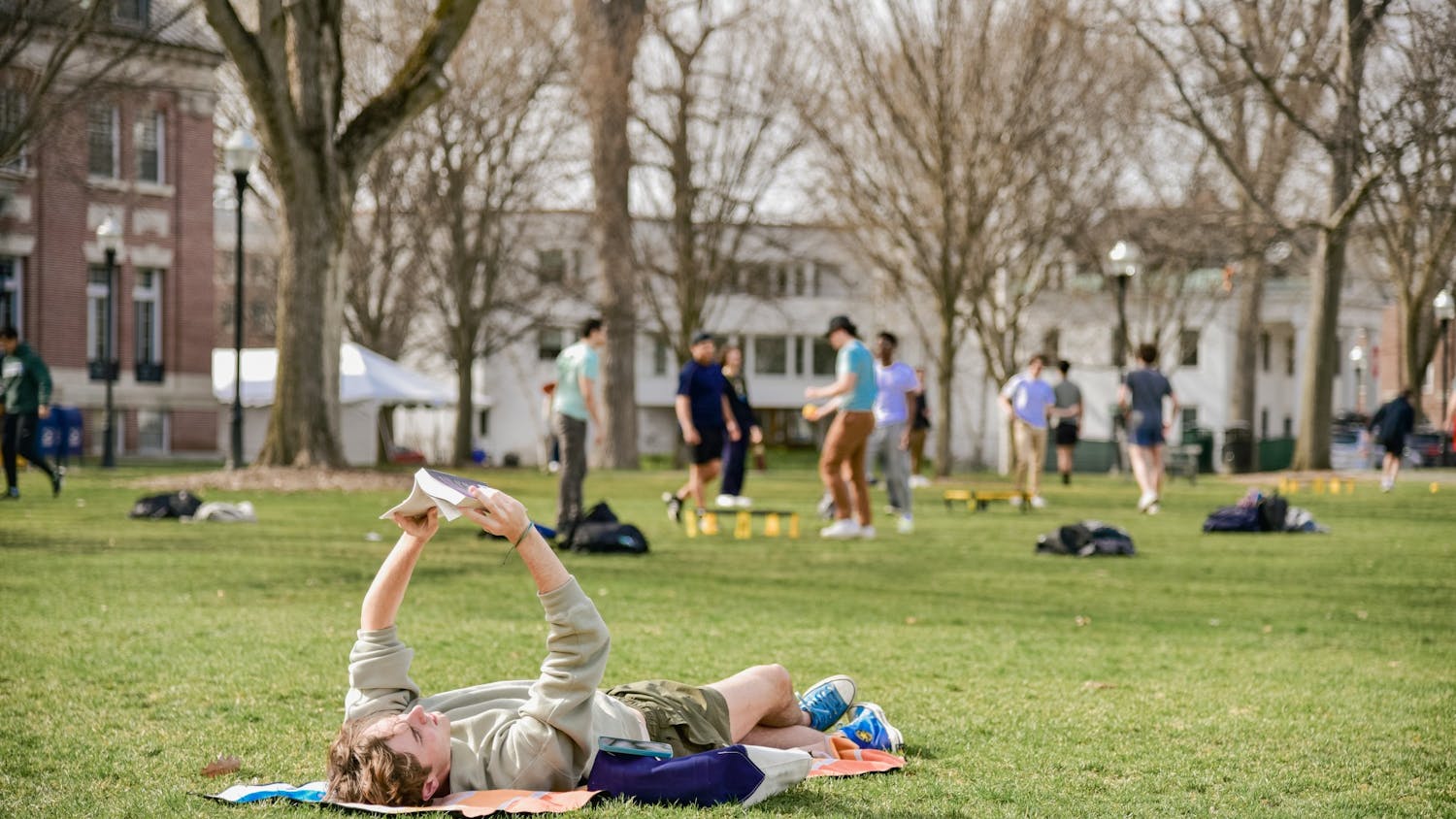This article is featured in the 2023 Commencement & Reunions special issue.
One of Dartmouth’s most special features is the accessibility of a wide variety of outdoor activities. However, participating in many of these activities necessitates a car ride, whether that’s hiking in the White Mountains or traveling to a nearby cabin. Yet, Ledyard Canoe Club is lucky enough to have the Connecticut River located just steps away from campus. Founded in 1920, Ledyard — a subclub within the Dartmouth Outing Club — offers both flatwater and whitewater canoeing and kayaking, as well as paddleboarding. Over the course of its century-long existence, the club has developed several traditions still in place to this day.
One such tradition is Ledyard’s annual Trip to the Sea. Each spring, members of the senior class set out on a 220-mile paddle down the Connecticut River. Over the course of a week, they travel from Hanover all the way to the Long Island Sound to recreate an expedition first embarked upon by the club’s namesake, John Ledyard. Former Ledyard president Chris Gaige ’23 called Trip to the Sea his favorite Ledyard tradition.
“You become really close with the people you are paddling with, even if they were complete strangers to you at the beginning,” Gaige said. “Several alumni groups throw parties for the Ledyard group as they make their way down the Connecticut, and it’s always fun to get to know them and enjoy the delicious food they have on the grill when our boats pull up.”
For Ledyardites who can’t wait until senior year for Trip to the Sea, Ledyard runs a Trip to the Source during sophomore summer, in which participants paddle from the source of the Connecticut River back to the Ledyard clubhouse.
Current Ledyard president Hayden Miller ’25, who planned and co-led the trip last summer, spoke highly of this tradition.
“Trip to the Source was one of my favorite outdoor experiences at this school and definitely my favorite Ledyard tradition I’ve gotten to participate in so far,” Miller said. “We canoed 61 miles over a long weekend and stayed at fantastic campsites on the river — one was on an island in the middle of the river.”
In addition to these mammoth paddling trips, Ledyard also hosts Riverfest every spring term, a weekend-long series of events including a race on the Mascoma River. Summer vice president and Riverfest coordinator Anna Chabica ’25 pointed out that Riverfest traditions — like hosting the race on the same river each year — can build connections across class years and serve as a reference point for students.
“The Riverfest race happens every year on the Mascoma River, so that people can do it and become better at it over the course of their time at Dartmouth,” Chabica said. “Traditions [like these] help us stay connected as both alums and current students. It’s cool to do something that you know so many other classes and students have done before you.”
In addition to these well-known traditions, club members have a host of other customs that are more obscure but no less meaningful.
Gaige stated that one “underrated” tradition is Ledyard’s weekly dinners — known as feeds — that take place every Thursday at the clubhouse.
“The menu changes every week, but if conditions are nice, you’ll more often than not find us working the grill,” Gaige said. “Alums from as early as the 1960s have visited and asked us if we’re still doing the feeds. They’re a great chance to unwind after a long week, and there’s no better place to do so than at the Ledyard Clubhouse on the shoreline of the Connecticut River.”
In addition to Riverfest’s well-publicized traditions like the race, Chabica also highlighted the tradition of “cheesing” people at the Riverfest party that occurs the Saturday night of Riverfest weekend.
“We take packaged cheese sticks and hide them in each other’s pockets, or in the cabin where we have the party, and if someone finds the cheese stick they have to eat it,” she said. “Cabot gives us hundreds of cheese sticks for free because they know that we have this tradition.”
Miller also noted one custom reserved just for position holders — an end-of-term dinner where the directorate members “celebrate” the work done over the term and set goals for the next one.
“It’s not a tradition that many people outside of the directorate know about, but I think it’s a nice way to reflect at the end of the term,” he said.
Though the endurance of these traditions is widely celebrated throughout the club, both Gaige and Miller noted a lost tradition they hope to revive — Ledyard’s racing program.
“Throughout the 1960s to the 1990s, Ledyard had a strong presence in the national and international canoe and kayak racing scene,” Gaige said. “We have produced national champions and even Olympic paddlers, but over the past few decades the club has drifted away from this high caliber level of competition.”
As president, Gaige focused on bringing Ledyard’s racing program back to its former glory.
“I took it upon myself to begin organizing and leading race practices, as well as entering us into several local races. While I don’t think we’ll be going to the Olympics soon, we did win the Northeast Collegiate Cup last fall,” Gaige said.
There’s no doubt that Dartmouth prides itself on its traditions, and Ledyard is no different. Whether those traditions involve a week-long, intensive canoe trip or a weekly meal down at the docks, each is designed to bring the members of the club closer together and bond them to those who came before.
Gaige noted that an exceptional aspect of Ledyard is its student-run nature — each of these traditions are not only shaped by, but endure because of the students who commit themselves to the continued success of Ledyard.
“I cannot emphasize enough how uniquely lucky Ledyard is as a club to be entirely student-run and self-sustaining,” Gaige said.
As one of the largest clubs on campus, it’s clear Ledyard has many students who love it. Though the reason for joining Ledyard differs for each member, Gaige pointed out that the strong community, shaped through the club’s many traditions, often plays a role.
“Ledyard’s ability to combine the sport of paddling with a deeply supportive community and social scene for people of all backgrounds and abilities makes it an attractive space for first year students to join as they begin their college careers at a place steeped in and surrounded by so much natural beauty,” Gaige said.




